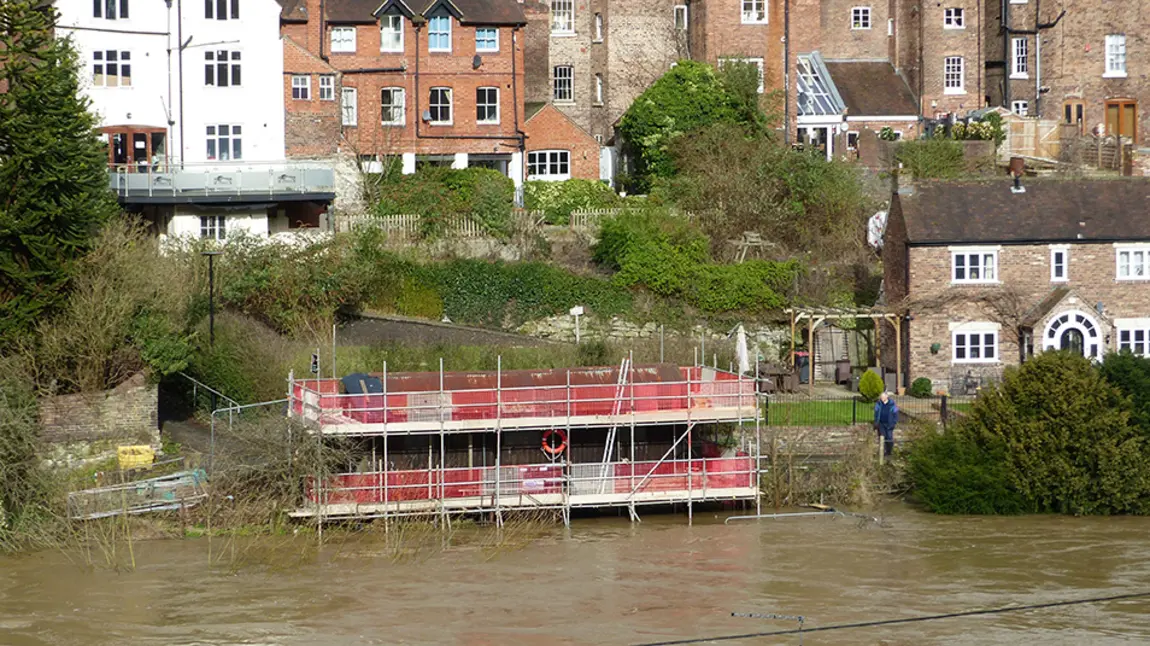Living and working in a threatened landscape

I count my lucky stars that for 30 years I have lived and worked in a stunningly beautiful landscape of Outstanding Universal Value: the World Heritage Site of Ironbridge Gorge.
As well as chair of the Ironbridge Gorge World Heritage Site Steering Group, I am project manager of the Ironbridge Coracle Shed project supported by The National Lottery Heritage Fund. The shed is located on the banks of the River Severn, where the Rogers family built coracles – traditional round boats.
Every 20 years or so, regular as clockwork, the River Severn is swelled with floodwater from Wales. It squeezes through our narrow gorge and rises a terrifying 6.8m above its normal level. It bursts the banks and inundates the historic cottages, warehouses, museums and people’s homes nearby.
Facing the floods

This year was far worse than usual. The combination of saturated ground and high rainfall meant there was nowhere for the water to drain away to. We were flooded three times in the space of two weeks.
Many people imagine that the World Heritage Site is just the Iron Bridge, the magnificent symbol of the Industrial Revolution that miraculously survived the Great Flood of 1795 and every one since. In fact it is a whole series of tiny historic settlements clinging to the steep sides of the Gorge. All of these are vulnerable to flood – and none have permanent flood protection barriers.
"As well as damage to historic properties there is a significant human cost and the community of the Gorge has taken a body blow to its wellbeing."
Last month, people’s lives were at risk as the temporary flood barriers along the historic Wharfage began to fail. People lost their livelihoods and the sanctuary of their homes, with all their precious photos and memories.
The Environment Agency, the emergency services and Telford & Wrekin Council provided a magnificent coordinated response to the crisis. But as well as damage to historic properties there is a significant human cost and the community of the Gorge has taken a body blow to its wellbeing. Many of our friends and neighbours will be forced to endure the disruption and stress of several months' evacuation from their homes and businesses.
Survival of the Coracle Shed

"Luckily we managed to get the new timber supports and braces in place just before the flooding struck, otherwise we would have lost the shed."
In 2019, the Ironbridge Coracle Trust received funding from The National Lottery Heritage Fund to undertake repairs to and conserve the old coracle shed. Built in the 1920s, it is perched precariously on wooden stilts on the riverbank. Luckily we managed to get the new timber supports and braces in place just before the flooding struck, otherwise we would have lost the shed.
We are now running about a month behind time but hope to have the works completed by the end of May. We are planning to tell the fascinating story of the coracle men via a Pepper’s Ghost and Coracle Trail up to the New Coracle Shed exhibition at the Green Wood Centre, built with financial support form Arts Council England and Telford & Wrekin Council.
Our luck has lasted, but we need to be prepared for next time.
What can heritage sites do to mitigate the impact of flooding?

Building permanent flood barriers in historic landscapes of Outstanding Universal Value is a difficult and expensive process and there is no central government funding for UK World Heritage Sites. Historic buildings affected by flooding require sensitive and careful treatment to recover from the impact of flood damage.
So what can we do?
- We need to plan ahead and prepare for these incidents which are going to become more frequent with the climate emergency.
- We need integrated flood risk management at a catchment level, to protect the historic environment from flood damage.
- We need to slow the flow of rivers and floodwater, and minimise the impact on vulnerable landscapes and settlements.
- There should be a significant re-think on development on flood plains. This can create impermeable hard landscaping and threaten landscapes and communities downstream.
- There needs to be a recognition that insurers won’t provide cover and home-owners need financial support to carry out conservation-standard repairs.
- Above all, we need to deliver on the government's commitment to genuine sustainable development and the response to the climate emergency.
As a member of The National Lottery Heritage Fund Midlands & East Committee, I believe we cannot and should not be expected to fund major infrastructure projects. But The Fund can use our reputation and influence to advocate for sustainable flood management for historic landscapes.
We are only temporary custodians of our past and we owe it to the next generation to protect their legacy.
Find out more
Find out on the Coracle Shed website and on their Facebook page.
The National Lottery Heritage Fund is currently updating its Environmental Sustainability guidance to reflect the environmental and ecological emergencies. This is our latest advice for projects.
- Marion Blockley is chair of the Ironbridge Gorge World Heritage Site Steering Group, member of the Midlands and East Committee of The National Lottery Heritage Fund and project manager of the Ironbridge Coracle Shed Project.

